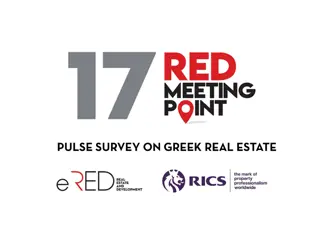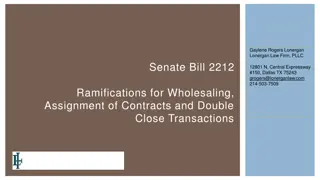Understanding For-Sale and For-Lease Real Estate Projects
Exploring the differences between for-sale and for-lease real estate projects, this content covers key concepts such as absorption, discounted cash flow valuation, and pathways to profit in investments. It compares the objectives, loan amortization lengths, and profit generation strategies for each type of project. Dive into a detailed analysis of discounted sellout models and the importance of subjectivity in for-sale investments.
Download Presentation

Please find below an Image/Link to download the presentation.
The content on the website is provided AS IS for your information and personal use only. It may not be sold, licensed, or shared on other websites without obtaining consent from the author. Download presentation by click this link. If you encounter any issues during the download, it is possible that the publisher has removed the file from their server.
E N D
Presentation Transcript
Subjective Real Estate Valuation G. JASON GODDARD
Chapter 8 Outline Chapter Highlights For-Sale Projects vs. For-Lease Projects The Skyscraper s Curse- for-sale projects and the macro economy The Case of the Discounted Sellout Valuation Subjectivity in For-Sale Investments
Chapter Definitions Absorption: When a property is leased or purchased after construction or renovation. Discounted cash flow (DCF) model: Income approach valuation methodology utilizing a multi-year view of the revenues and the expenses for a property which are received during the defined holding period of the investment. Discounted Sellout: valuation model used in for-sale investment scenarios. Payback ratio: In for-sale projects, it is the relationship between the required loan repayment per unit relative to the amount of loan per unit. Qualified presale: In a for-sale project, where a prospective buyer has put down deposit towards purchasing a unit and has been approved for a loan by a financial institution.
For-Lease vs. For-Sale Projects For-Lease: Objective is to lease to third party tenants for an amount higher than the operating expense and associated debt payments Traditional loan amortization lengths (20-25 years) Reversion: sale of the property at the end of the holding period. For-Sale: Objective is to build and sell the units, pay back the lender, and generate a profit as quickly as possible Much shorter loan amortization lengths (3-7 years)
For-Lease vs. For-Sale Projects Pathways to Profit in For-Sale Investments
For-Lease vs. For-Sale Projects Total Lots 15 Discount Rate 10% 4 Year Discounted Sellout Avg. Sales Price Sales Revenue Less Sales Cost Net Sales 125,000 1,875,000 $ $ 1,781,250 $ $ Year # Units Sold Avg. Sales Price Total Monthly Sales Discounted Value Total Value 1 4 2 3 3 4 4 4 15 93,750 5% 125,000 500,000 454,545 1,481,627 $ $ $ $ 125,000 $ 375,000 $ 309,917 $ $ $ $ 125,000 500,000 375,657 $ $ $ 125,000 500,000 341,507 Discounted Sellout Model
For-Lease vs. For-Sale Projects Total Lots 15 Discount Rate 10% 4 Month Discounted Sellout Avg. Sales Price Sales Revenue Less Sales Cost Net Sales 125,000 1,875,000 $ $ 1,781,250 $ $ Month # Units Sold Avg. Sales Price Total Monthly Sales Discounted Value Total Value 1 4 2 3 3 4 4 4 15 93,750 5% 125,000 500,000 454,545 1,779,051 $ $ $ $ 125,000 $ 375,000 $ 351,914 $ $ $ $ 125,000 500,000 484,365 $ $ $ 125,000 500,000 488,227 Discounted Sellout over Four Months
Skyscrapers Curse Tallest Skyscraper s Throughout History
Skyscrapers Curse Building Location NYC Chicago Chicago NYC NYC NYC NYC NYC NYC NYC NYC NYC NYC NYC Chicago Malaysia Taiwan Dubai Saudi Arabia # Floors Height (ft.) Record Completion 7 130 10 138 17 222 20 309 18 348 26 390 47 612 50 700 57 792 70 927 77 899 102 1,224 110 1368 110 1362 110 1450 88 1483 101 1671 154 1918 167 2139 Crisis Equitable Life Assurance Home Insurance Auditorium Building NY World (aka Pulitzer) Manhattan Life Insurance Park Row Building Singer Building Metropolitan Life Insurance Woolworth Building 40 Wall Street (aka Trump Building) Chrysler Building Empire State Building World Trade Center I World Trade Center II Sears Tower Petronas Towers Taipei 101 Burj Khalifa Jeddah Tower 1870 1884 1889 1890 1894 1899 1908 1909 1913 1930 1930 1931 1973 1973 1974 1999 2003 2010 2021 Black Friday Sept 24, 1869 Panic of 1884/Depression 1882-85 Panic of 1890 (Baring Crisis) Panic of 1890 (Baring Crisis) Panic of 1893 4th largest quarterly GNP decline just before opening Construction just before Panic of 1907 Construction just before Panic of 1907 23 month contraction prior to start of WWI Great Depression Great Depression Great Depression 1970s Stagflation 1970s Stagflation 1970s Stagflation Asian Financial Crisis Dot-com/Tech Bubble Housing Bubble/Great Recession COVID-19 Lockdowns Skyscraper Curse Through History
The Case of the Discounted Sellout Year 1 5 150,000 Year 2 112,500 12 Year 3 4 115,875 Year 4 4 119,351 Year 5 4 122,932 Units Sold Avg Unit Sale Price Units Leased 3 $ $ $ $ $ 15 8 4 0 Expected Sales and Leasing
The Case of the Discounted Sellout Year 1 Year 2 13,905 1,391 2,575 4,867 Year 3 14,322 1,432 2,652 5,013 Year 4 14,752 1,475 2,732 5,163 Year 5 $ 1,519 2,814 $ Annual Rental/Unit HOA Dues/Unit RE Taxes per unit Condo Leasing Exp $ $ $ $ 13,500 1,350 2,500 4,725 $ $ $ $ $ $ $ $ $ $ $ $ - $ $ - Expected Operating Performance of Leased Units (in dollars)
The Case of the Discounted Sellout Year 0 Year 1 750,000 202,500 979,500 Year 2 337,500 27,810 166,860 532,170 Year 3 463,500 28,644 114,577 606,722 Year 4 477,405 29,504 59,007 565,916 Year 5 491,727 30,389 522,116 Condo Sales Revenue HOA Revenue Condo Leasing Revenue Total Gross Revenue 27,000 - Commissions Marketing Costs Overhead & Contingencies RE Taxes Homeowners Dues Leasing and Op Exp Total Expenses 5% 2% 2% 38,850 15,540 15,540 50,000 27,000 94,500 241,430 18,266 7,306 7,306 51,500 20,858 97,335 202,570 24,607 9,843 9,843 53,045 17,187 100,255 214,780 25,345 10,138 10,138 54,636 11,801 103,263 215,322 26,106 10,442 10,442 56,275 6,078 109,344 - Net Operating Income Aggregrate Principal Reduction Annual Principal Reduction Interest Expense Debt Coverage Ratio Net Cash Flows BTIRR On Equity Discounted Cash Flows Property Value % of Loan Outstanding 738,070 500,000 500,000 50,000 329,600 800,000 300,000 25,000 $ 391,942 1,000,000 200,000 10,000 $ 350,594 1,000,000 $ 412,772 $ - - $ - - 5% 1.34 1.01 4,600 1.87 (850,000) 8.40% 188,070 181,942 350,594 412,772 1,550,000.00 $ 50.00% 163,539 3,478 119,630 200,453 205,221 100% 20.00% 0.00% 0.00% 0.00% Discounted Sellout Model for Workout Condo Project
Chapter 8 Questions Questions for Discussion Discuss the various for-sale investment property paradigms while noting the strengths and weaknesses of the various pathways. Explain the difference between the appreciation reversion and the terminal cap rate reversion. Outline how the lack of a reversionary cash flow in the for-sale investment property valuation model can bring increased uncertainty and increased valuations ranges. Compare and contrast the discounted sellout valuation model with the discounted cash flow valuation model. Identify the root cause of the skyscraper s curse and what it says about the economic cycle.
Chapter 8 Questions Questions for Discussion Provide examples how the skyscraper s curse impacts other areas of the economy. Describe how a lender can utilize the payback ratio to structure for- sale project financing. Describe the types of pre-sales and how their presence can shape the risk profile for a particular for-sale property venture. What is market absorption and why is it a key ingredient for success in for-sale ventures? What are the primary areas of subjectivity in for-sale investment property projects?
Chapter 8 Market Vignette Questions for Discussion Discuss the plans for development in Saltville. Are Eb and Bob forgetting anything significantly important at this stage of planning? Discuss the planning stages in light of the pathways for profitable for- sale relationships model highlighted in the chapter. Does the plan for making the residential properties for-sale, but planning for the retail properties as for-lease make financial sense? Present both sides and defend your argument. Discuss how you might construct a discounted sellout model for the homes and any pitfalls in the valuation. What basic assumptions are still unknown from this case? Discuss how you might construct a direct capitalization income approach model for the retail space. What basic assumptions are still unknown from this case?























